 Businesses Act, 1991 (Act No. 71 of 1991)
Businesses Act, 1991 (Act No. 71 of 1991)
R 385
Broad-Based Black Economic Empowerment Act, 2003 (Act No. 53 of 2003)Industry ChartersChartered Accountancy CharterSection A: Background4. Why a Sector Code for specifically the CA Profession |
In Statement 300 of code series 000 it is stated that there should be common commercial and other characteristics within the entities operating in the sector which would make it feasible to formulate a transformation Sector Code.
This is indeed the case in the CA profession, where the entities operating in the sector share a number of commercial and other characteristics which makes it feasible to formulate a common transformation Sector Code for this sector of the Accountancy profession.
The vision of this transformation Sector Code is to grow the number of black people in the CA profession to reflect the country's population demographics and to empower and enable them to meaningfully participate in and sustain the growth of the economy, in the process advancing equal opportunity and equitable income distribution.
The CA profession believes that this can be achieved by bringing together all the entities (indicated in paragraph 3.2) operating in this sector, by means of a transformation Sector Code in which all participants will contribute to the achievement of this vision.
Having people with proper financial and management skills is vital to any economy. CAs(SA) provide these much needed skills, but in South Africa at present there is a shortage of CAs(SA) and in particular black CAs(SA). This is on the agenda of National Treasury and the Auditor-General.
The development of a Sector Code for the CA(SA) profession in fact stems from the numerous interactions with the organs of state; specifically National Treasury, the Office of the Auditor General, the IRBA (previously the PAAB), and the Financial Services Board.
CAs(SA), and particularly black CAs(SA), have been identified as being a critical skill which is in short supply and of national strategic importance. This situation needs to be rectified, hence the need to develop a Sector Code for the CA(SA) profession.
The CA profession currently runs numerous programmes to assist students from disadvantaged backgrounds with entry into the profession. However, since 1976 when the first African, Professor Wiseman Nkuhlu, qualified as a CA, only 912 Africans have registered as CAs.
The CA sector has thus come to realise that transformation will take too long if left purely to economic forces, and that active intervention on a very large scale will be required to redress the situation so as to achieve a restructured business environment in which business and organisational composition reflect population demographics.
The aim of black economic empowerment (BEE) initiatives in the CA sector is therefore to significantly increase the number of black people that manage, own and control enterprises in the sector as well as to contribute to decreases in income inequalities in the country in general. This is to be achieved by means of an integrated and coherent socio-economic process that directly contributes to the economic transformation of South Africa.
Within the CA sector, the first step and primary focus will be on dramatically increasing the numbers of all black participants (Africans, Indians and Coloureds) and particularly African CAs.
The figures below illustrate the population demographics of South Africa, according to population, in comparison to the economically active population, and the demographics of SAICA membership and trainees:
Figure 2.1 illustrates the economically active population as at March 2007: In the first graphic this is compared to the South African population and the second contains a comparison to membership of SAICA.
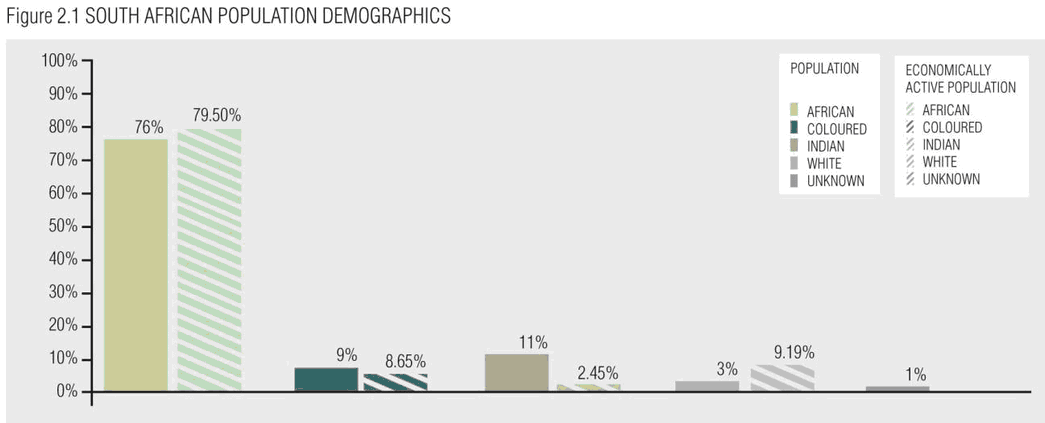
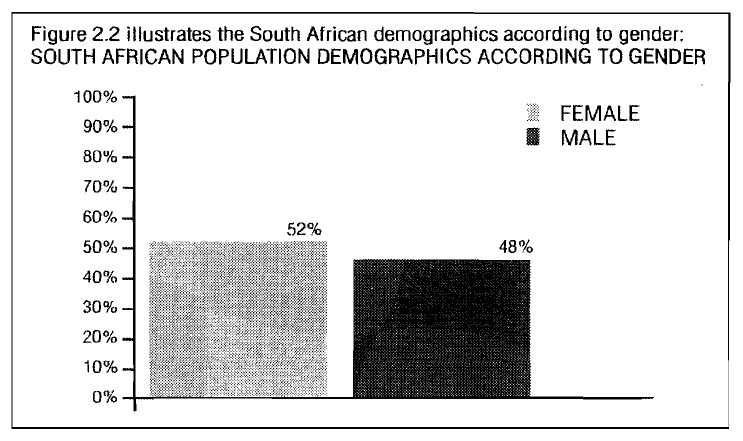
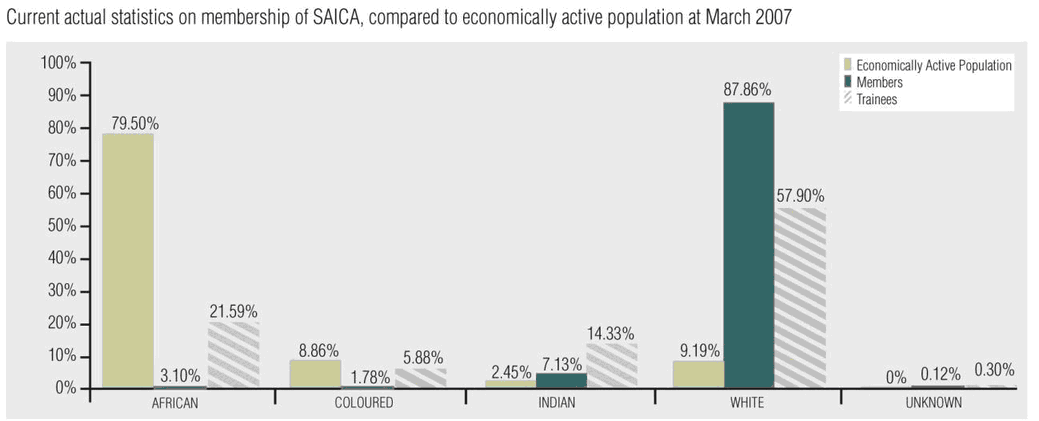
Current actual statistics on membership of SAICA, excluding overseas members, are represented in figure 2.3 according to race and in figure 2.4 according to gender:
Figure 2.3
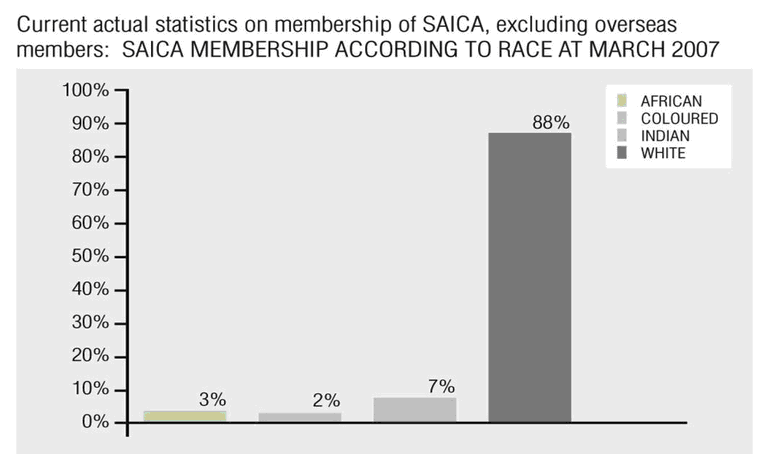
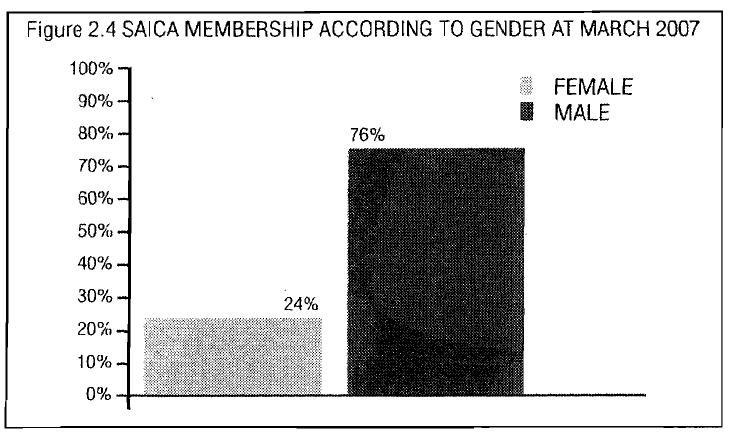
The current actual statistics of trainees registered with SAICA as at the end of March 2007 are illustrated in figure 2.5:
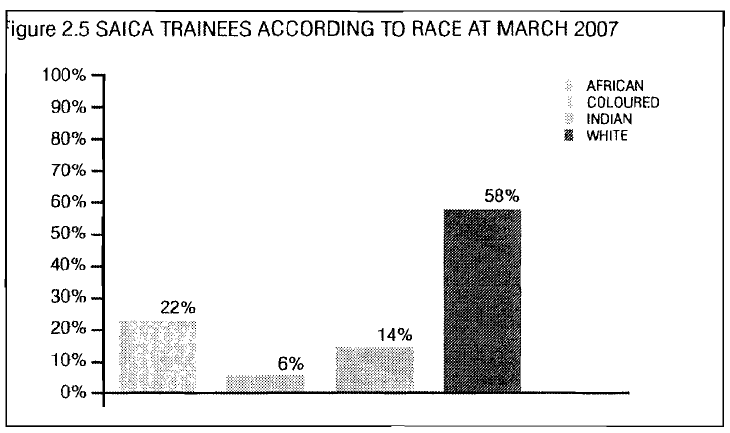
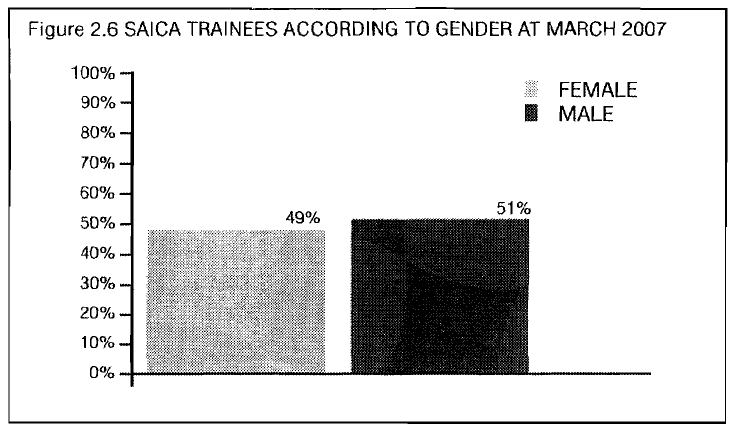
The actual numbers bear witness to the extent of the challenge facing the CA profession, and hence, the South African economy.
We, as parties to the CA Sector Code, therefore commit ourselves to actively promoting a transformed, dynamic and globJIIy competitive CA profession that will reflect the demographics of the South African population and contribute to the establishment of an equitable society by implementing a strategy that will-
| • | improve both access to the profession and progress towards becoming CAs; and |
| • | uplift communities for the benefit of the South African society and the economy as a whole. |
The Sector Code of the CA profession is characterised by the following:
| • | It embraces the spirit of what government intends to achieve with B-BBEE rather than being rules driven; |
| • | The CA profession is unique in that it is directly involved in the development of CAs and RAs who often take up leadership positions in the economy and society as a whole; |
| • | It was developed voluntarily; |
| • | It is a Sector Code aimed to transforming the CA profession in accordance with the spirit of B-BBEE legislation; |
| • | It constitutes a framework and establishes principles from which B-BBEE will be implemented in the CA profession and sector; |
| • | It represents a partnership programme with government as outlined in the government's strategy for B-BBEE; |
| • | It provides the basis for engagement with other stakeholders, including but not limited to, providers of education and training, regulators, government and labour; |
| • | It establishes quantitative targets and qualitative responsibilities in respect of each indicator of the scorecard; and |
| • | It outlines processes for implementing the Sector Code and mechanisms for monitoring, measuring and progress reporting. |
We, as the CA profession and sector, have the skills to contribute to the transformation strategy as set out by government and as such also to contribute towards increasing equitable income distribution and equal opportunities.